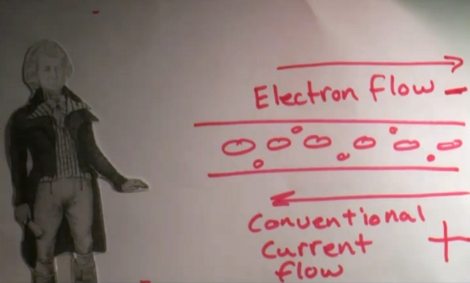
Remember how fun it was studying chemistry and physics in high school? Well we guess your recollection depends on the person who taught the class. Why not have another go at it by learning the A-to-Z of electronics from one of our favorite teachers, [Jeri Ellsworth].
You know, the person who whips up chemistry experiments and makes her own semiconductors? The first link in this post will send you to her video playlist. So far she’s posted A is for Ampere and B is for Battery, both of which you’ll find embedded after the break. Her combination of no-nonsense technical explanation, and all-nonsense paper-doll history reenactment make for a fun viewing whether you retain any of the information or not.
[youtube=http://www.youtube.com/watch?v=DSj1SH5Zpqg&w=470]
[youtube=http://www.youtube.com/watch?v=XOxMUZUJUS4&w=470]
[Thanks PT]
















pretty cool. 1st!
Jeri Ellsworth is definitely towards the top of my list of most awesome people in the world.
I’m taking my production values to a new low with these videos.
Good stuff :)
Current does not flow! Current IS flow. Let’s not promote these misconceptions.
Simple, straightforward and hand-drawn. Just like those great Forrest M. Mims III books from Radio Shack. Great stuff Jeri!
I am a big fan of Jeri.
I stop into her chat and stream, often.
good community of DIY folks in there.
her recent “paper doll” video takes me back the the always excellent “secret life of machines”.
great stuff Jeri.
Totally worth the time to watch especially the huge pile of 9V batteries burning electrodes! Awesome stuff :)
Nice video. I watched your “don’t be afraid to fail” vid also. It has a really great message for everyone, of every age. Most of us try to hide our failures, or don’t try if we think we might flop. Thanks for sharing.
Love it! When do we get to differential equations in circuit analysis?
@Min
She explains current flow properly in that video.
She in fact, states that current is the flow.
If you’re going to nitpick at-least have the decency to be right.
Tubby if you did not already know they have all the episodes available for download on their site
http://www.secretlifeofmachines.com/dvds_and_videos.htm
I have them all on my xbox =)
@Edward
Why would I watch a video that in the sole screenshot has a critical error?
@Min you’re obviously not familiar with Jeri’s work. She’s got to be one of the best DIY electronic engineers out there right now, and I’ve found her videos to be INCREDIBLY informative (she needs her own “Jeri Ellsworth Certification” online course…)
Jeri’s videos should be on DVD, and need to accompany the “Getting Started in Electronics” textbook by Forrest M. Mims III.
Awesome work, Jeri — keep up the excellent work!
@Min – also, watch the video…she states “Current IS the flow of charge”…
Gotta love it when trolls make comments before checking out the supplied resources.
@min If an economics professor posted an insightful video explaining the financial system (and you were interested in that sort of thing) would you choose to miss out simply because a screenshot has a drawing of an “ATM machine”? Sure it’s redundant, but it’s common parlance.
Besides which, certainly when you first flip the circuit on, ∂j/∂t = -Δj ≠0, so it certainly makes sense to define a “current flow” as the current propagates back along the wire.
Great as always!
Brad
Is there anything Jeri doesn’t do?
Because her stuff repeatedly takes DIY beyond anything Ive ever seen.
My roommate did the whole massive stack of 9V batteries thing not too long ago. I don’t know where he got them, but he found a pack of 40 or so 9Vs that were dirt cheap. Blew up wires, did some pretty significant electrolysis, and managed to light up his desk lamp with them.
Not only are the lessons great, but I’m happy to see the cool handhelds in the background too.
Thanks for posting this HAD, and thank you for making this Jeri.